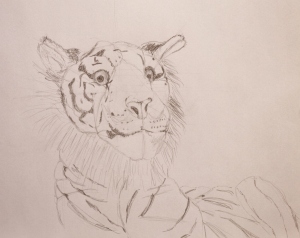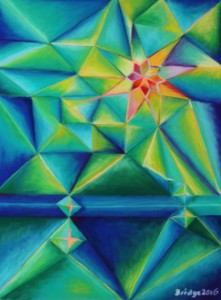Tigers: Endangered animals and their habitat
Toys: Great for learning about animals, anatomy and drawing for all ages
Backgrounds: Complementary shapes on a two-dimensional surface
Tiger, Toy and Drawing
I own a big toy tiger whom I like very much. His name is Romeo. He is at least one meter long and with all the correct proportions of a real one. During a drawing class a while ago, I made a pencil sketch of him on an A3 pad. And left it at that.

For more on how to draw see my blog post “How to Draw – A Portrait of an Elephant” @ How to Draw – Portrait of an Elephant
For some reason, children are generally mad about tigers. When they see my big soft cat, they just run over and cuddle him which he likes very much.
Hopefully, they will continue to exist in the wild, not only in the zoos or as toys.
Drawing to Canvas
Recently, I got a copy of that tiger drawing, traced over it with text marker and put it on the back of a canvas, placed it against the window and copied my drawing onto the canvas with a pencil. Doing the original drawing from the object took me about two hours!!! And severe concentration!
The Painting Process
Colouring
Having the proportions right, I started painting the eyes and all the black marks with acrylics. It looked like an abstract. I needed the black marks for orientation and I can just paint over them. They would always be clearly visible.
The next step was putting in the golden shades for the fur. I chose yellow ochre for that. It comes close to the natural colouring of tigers and mixes well with black for shading without going greenish.
Still looking a bit abstract. Not that I dislike abstracts. On the contrary. But I wanted this beauty looking realistic.

Background or Another SHAPE
That done, I had to start thinking about the so-called background. Occasionally, I hear from people: “It’s only the background”, meaning it is of minor importance.
Well, NEVER!!! – EVER!
The background should bring out the object. Object and background are closely connected. Just imagine: A tiny piece in a puzzle missing ruins the whole picture, doesn’t it?
Also, pictures – as we think of them – are usually on a two-dimensional plane, mostly a rectangle. This picture plane is divided into shapes by lines and/or colours. Ignoring one is like leaving a hole in the picture. One shape determines the other. In other words: they complement each other. That’s why they are often called complementary shapes.
Sometimes they are referred to as positive and negative spaces or shapes. However, I find this rather misleading. The whole concept has nothing to do with positive or negative. All shapes are equally important!!! What about abstract pictures? How determine what’s positive or negative there??? Uhhh… hmmm…
 Dazzling Diamonds, pastel, 2016
Dazzling Diamonds, pastel, 2016
What have I done? So many shapes … I’m getting lost here! Where’s the background, positive shapes, negative shapes????? – Help! Who can help me out here?
Let’s get away from this and back to Romeo what-a-relief!
My tiger is a certain shape. The “rest” of the picture makes up the other shape, meaning I have two main shapes in this painting: The tiger and the surround. Very simple in this case. Well, it seems so simple now! (Correctly, it is not quite so simple but let’s ignore that for now.)
Let’s have a quick break from that hassle.
Back to the Real Tigers
For a start, I had a problem. I wasn’t sure what to do with my tiger. Where to place him. On a sofa perhaps? Where exactly do tigers live? What are their habitats? Would they have sofas there????? – What!?
New info: Tigers need shelter (yes!), food and water. They mainly live in the jungle or in grasslands with high grass and some trees – at least the yellow stripy ones. There are lots of different tigers out there. However, my toy-boy is yellow, white and black and therefore the high grass type (see more info @ defenders.org/tiger/basic-facts ). No sofas there! (I bet they would like it, wouldn’t they just?)
The colours of the grasses would be natural shades like yellow ochre, burnt sienna, black and some green. Just like the tiger, apart from the green.
Aha! I had an idea!
Complementary Shapes
I was thinking before of painting everything around the tiger just black. But what then? I decided to do a test on a separate paper with black and then burnt sienna and yellow ochre stripes on top. That looked allright.
Then I went about filling the shape surrounding the tiger with black paint which brought him out nicely as he is painted on white. So these two main shapes (them again!) are originally black and white, right? The black part complementing the white one, the two of them together making up one picture. You get my drift.
Next step I put irregular stripes with burnt sienna on the black shape, wet on wet, then yellow ochre wet on wet, all happily blending in.

These shapes are overlapping in places like the beard. That connects them as you can see in the next picture.
 This is the finished painting of my Romeo.
This is the finished painting of my Romeo.
Tigers, toys and backgrounds: Art brings them all together quite nicely.
Some more very good examples for shapes defining the picture (all my own paintings) as follows:

The Savoy, acrylics, 2015
Very simple indeed, consisting of only four shapes in different colours which are basically joined at a focal point. More on focal points you can find in my post “Awesome Autumn – About Colours, Composition and More” @ Awesome Autumn – about colours, composition and more

 Irish Landscape with Tree, watercolour, 2017 The Green Bridge, acrylics, 2017
Irish Landscape with Tree, watercolour, 2017 The Green Bridge, acrylics, 2017

 Orange and Blue, photo, 2016 The High-flying Red Teapot, acrylics, 2016
Orange and Blue, photo, 2016 The High-flying Red Teapot, acrylics, 2016
 The Missing Teapot, acrylics, 2016
The Missing Teapot, acrylics, 2016
See the SHAPE of the missing teapot? Not even a teapot there. I just painted a hole in the picture or in the wall in this case. Uhhhh… is this positive or negative now??? Like the hole in the puzzle?? Oh dear! – Maybe we stick with the SHAPES. What do you think? Complementary ones! They make up the picture. You get the picture!!
It really doesn’t matter whether it is a photo, a painting, a collage, a flyer with text only or whatsoever: Same rules apply. Always!!!
These are very simple examples. Most pictures are far more complicated but for learning or explaining these are ideal.
And I was “just” painting my toy-boy!!! Would you believe it???
For more info on “The Savoy” see: The Savoy @ Portrait of a Cabbage
or just visit my website @ arthenning.com
You can also find me on Google’s blogger @ artandphotographyhenning.blogspot.com
